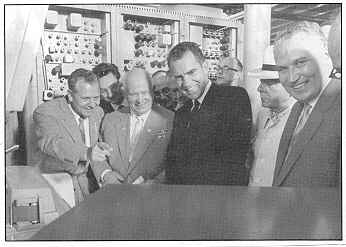Case Study: Kitchen Debate
 The use of video to record these debates between then Vice-President Richard Nixon and Russian leader Nikita Khrushchev allowed the public in the United States to view events occurring on the other side of the world much closer to the time it took place than ever before. The videotaped debates also influenced the world leaders. Their words and gestures would be seen and heard all over the U.S. and Russia, and they knew it. The politicians were aiming to have a positive affect on the other’s countrymen through the televsion.
The use of video to record these debates between then Vice-President Richard Nixon and Russian leader Nikita Khrushchev allowed the public in the United States to view events occurring on the other side of the world much closer to the time it took place than ever before. The videotaped debates also influenced the world leaders. Their words and gestures would be seen and heard all over the U.S. and Russia, and they knew it. The politicians were aiming to have a positive affect on the other’s countrymen through the televsion.
The "Kitchen Debate" of 1959 was one of a series of discussions between the two leaders, one of which took place at the U.S. Trade and Cultural Fair in a model kitchen exhibit.
The exhibit shown in Moscow in 1959 by the United States included RCA color television and Ampex videotape. Nixon met with Khrushchev and opened the American exhibit. In one of the dialogues between the leaders, Nixon, "recommended [the color televsion and videotape] as ideal instruments for an exchange of ideas" (Barnouw).In 1958, when Khrushchev became the Russian leader, he approved a program which would allow the U.S. and Russia to share various aspects of the cultures with each other. The U.S. and Russia were currently involved in the space race and tensions were high. Both Khrushchev and Nixon were thinking of the influence they could have on the other’s country by appealing to them through the televised event. "The world was entering a period when the planning of television spectaculars was becoming a central activity of rulers" (Barnouw). The two leaders were influenced by the presence of the video cameras, both wanting represent their country well. Khrushchev toured the U.S. soon after and his visit was also televised.
Another important aspect of the "Kitchen Debate" is that the newsreel which contained footage of a news conference between Nixon and Khruschev was censored by the U.S. government. This was the first occurrence of government censor in the histroy of the newsreel.
Sources:
--Erik Barnouw’s Tube of Plenty, Oxford University Press (1990).
--cwis.usc.edu/dept/raiders/story/rockets.html
--ac.acusd.edu/History/20th/kitchendebate.html

